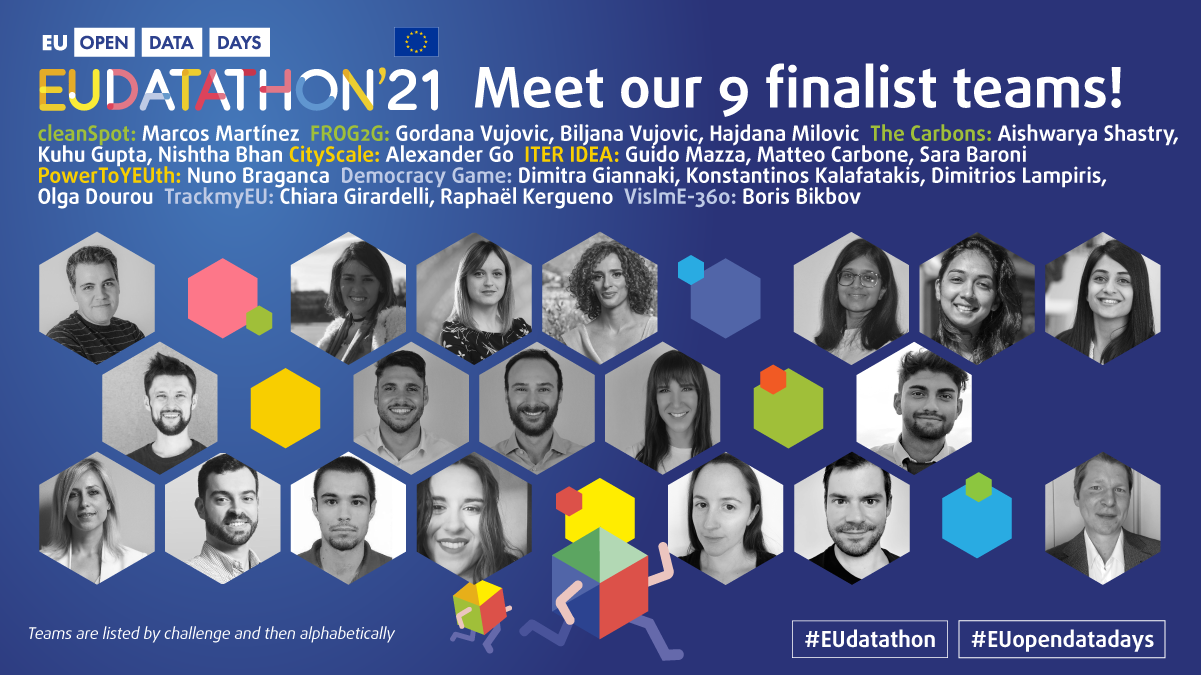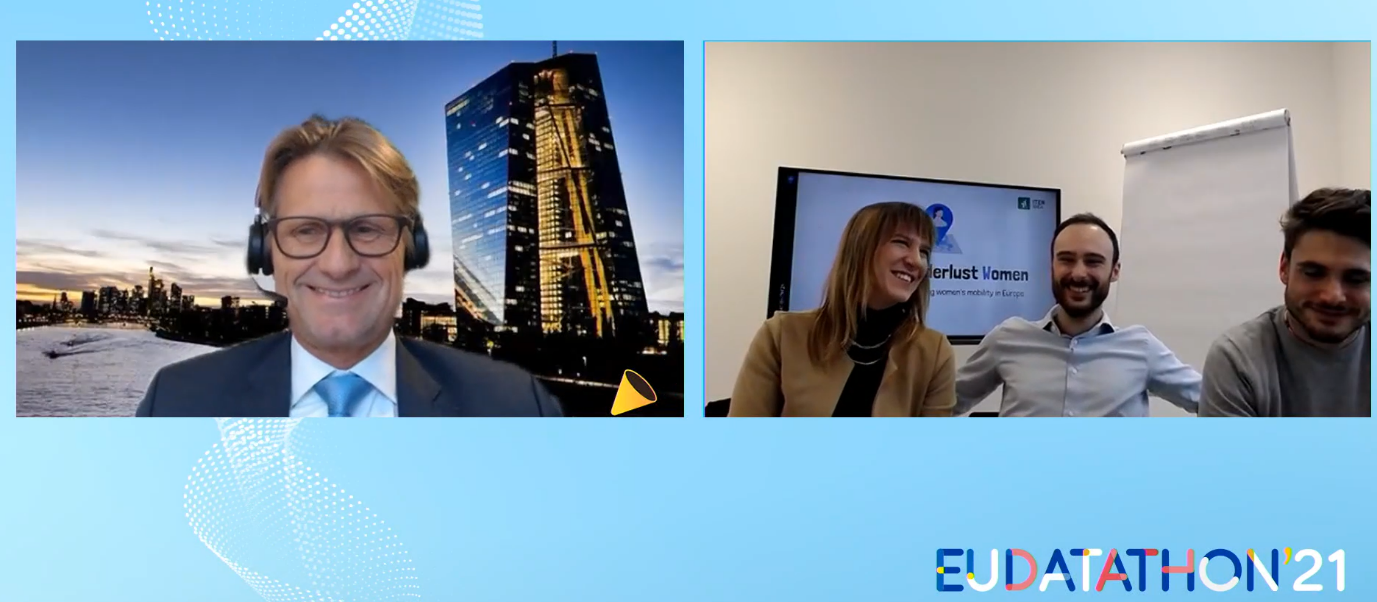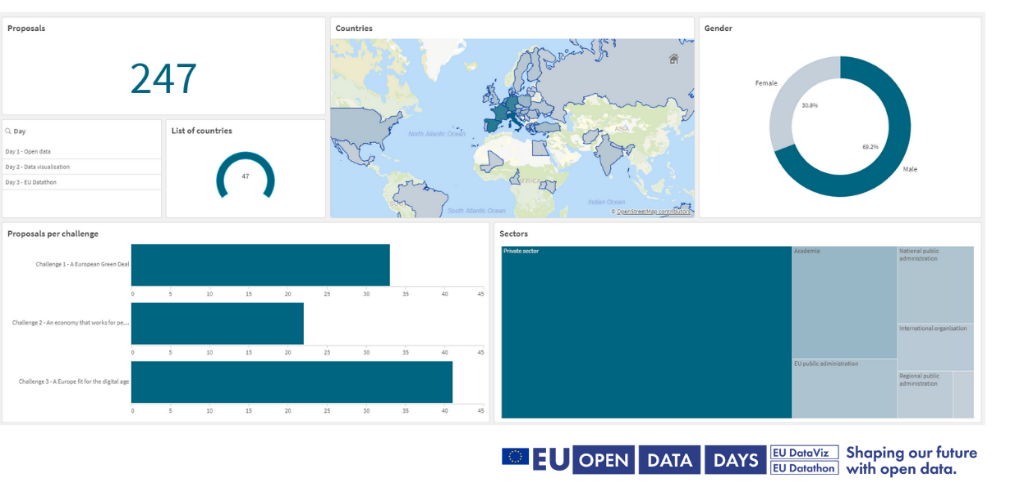On a mission to shape our digital future
A recap of the EU Open Data Days
On a mission to shape our digital future
The first ever EU Open Data Days took place from 23 to 25 November 2021. The event hosted EU DataViz, an international conference on open data and data visualisation, and the annual open data competition, EU Datathon.
Why the EU Open Data Days?
An increasing number of states and governments around the world recognise the value of open data and take initiative to publish open data sets. The European Union makes no exception. On the contrary, according to the European data strategy presented by the European Commission in February 2020, the EU ‘aims to be a leader in a data-driven society’. Among all data, including big data or privately owned data, open data has a special status. It responds to a set of technical, economic and legal criteria: it must be freely available online and in a format allowing reuse.
The EU Open Data Days brought open data into the spotlight in a three-day event. Under the tagline of Shaping our future with open data, the event featured the second iteration of EU DataViz, an international conference on open data and data visualisation for the benefit of EU public administration, and the finals of the fifth edition of EU Datathon, a competition for application developers from around the world.
The beauty of open data and its visualisation
The EU DataViz conference aimed at sharing experience and best practices related to open data and data visualisation, with Day 1 focused on open data and Day 2 on data visualisation for the EU administration. In the opening speech, Prime Minister of Luxembourg, Xavier Bettel, offered insights into digital initiatives of the Grand Duchy of Luxembourg and underlined open data as a source of innovation: ‘Data is said to be the oil of the 21st century. I don´t think this is accurate. Data has more value and potential than oil back in the days. Unlike oil, data is a renewable resource. It fuels new technologies, such as AI, block chain, the internet of things and virtual reality. Data enables constant creation of new applications.’
The plenary speaker Yvo Volman from the European Commission, a founding figure of the European open data policy, set the stage for inspiring debates. He recalled the origins of the European data strategy, contextualised the EU´s plan for building a single European market for data and provided an outlook of near-future activities: ‘We are shortly going to launch a consultation on high value datasets. There will be a month of consultation on the draft implementing act, and after that we have to go through the comitology procedure with the Member States before the Commission can adopt the implementing act.’ His words anticipated the announcement of a provisional agreement on Data Governance Act on 30 November, ‘a new law to promote the availability of data and build a trustworthy environment to facilitate its use for research and the creation of innovative new services and products’.
Other contributors discussed a double challenge that open data currently faces, both in terms of supply and demand. The availability of data is still under construction and various sectors witness initiatives in favour of openness. Many such initiatives from EU Member States and further afield were presented by more than 50 conference speakers. In addition to the challenge of availability, there is also the issue of interoperability and silos. Even if data is available in different territories or sectors, it often lacks interoperability, which hinders the development of large-scale digital services.
Day 2 of the EU DataViz conference was opened by Minister of Public Administration of Slovenia, Boštjan Koritnik, representing the Slovenian Presidency of the Council, and it centred on data visualisation for the EU administration. An array of topics was introduced, from the basic concepts to the latest trends, with numerous examples of successful data visualisation projects. Data visualisation was explored from many perspectives, e.g., as a vector of innovation, a key to turning open data into compelling insights, and a vehicle for sharing knowledge and storytelling.
In his concluding remarks, the president and co-founder of the Lisbon Council, Paul Hofheinz, offered his way of looking at open data: ‘To me, the beauty and power of data visualisation is the knowledge that we can generate with it. It´s the way that we can take data, which is – let´s face it – a boring pile of statistics and numbers, and turn it into something useful and understandable that moves us forward as a society.’
Open data in action
Using open data to create something useful and understandable that moves us forward as a society is what EU Datathon is all about. This annual open data competition invites innovators from all over the world to propose ideas for applications that address the priorities of the EU and use datasets published at the official portal for European data, data.europa.eu. The finals of this year´s EU Datathon crowned the final day of the EU Open Data Days.
The contest was opened by Commissioner Johannes Hahn who reminded the audience that ’moving forward is not always constrained by a lack of technology, but often by a lack of an appropriate mindset’ and appreciated the competition for giving floor to many innovative ideas of the course of its existence. Nine teams shortlisted for this year´s final pitch presented newly designed but fully functional apps that addressed one of the competition´s three challenges. Up for grabs was the prize fund of EUR 99 000, and the Public Choice Award.

A jury of 18 data specialists chaired by Per Nymand-Andersen (European Central Bank) selected the winners for each challenge:
CHALLENGE 1: A EUROPEAN GREEN DEAL – THE CARBONS (India)

This is a responsible food-lover´s dream app. It maps the carbon footprint of food items and helps users make environmentally friendly food choices.
CHALLENGE 2: AN ECONOMY THAT WORKS FOR PEOPLE – ITER IDEA (Italy)

Better mobility for young female professionals. The team of ITER IDEA presented a portal called Wonder Wanderlust Women that connects young women to career opportunities abroad by matching the user´s field of study, language skills and budget with job offers across Europe.
CHALLENGE 3: A EUROPE FIT FOR THE DIGITAL AGE – TrackMyEU (France, Italy)

This app helps the user explore and contextualise EU policies. Information can be sorted, ranked, and filtered according to individual preferences.
The Public Choice Award was the last surprise of the day to be revealed, and after moments of suspense, it was bestowed on the team of ITER IDEA. The full results of EU Datathon, together with short videos about the finalist teams, are available on the EU Datathon site.

The EU Open Data Days in numbers
- A call for submissions of proposals for both parts of the event closed on 21 May 2021. It attracted 247 proposals.
- The 247 proposals came from 47 countries, including 24 EU Member States.
- The event attracted well over 2.000 registrations from data enthusiasts, experts and solution-seekers.
The EU Open Data Days were organised by the Publications Office of the European Union, with the active support of over 60 partners, representing the data providers from EU institutions and agencies, European national open data portal and national statistical offices, and key digital players in Luxembourg. The official press release and other promotional materials are available on the EU Open Data Days site. Video recordings of all contributions will soon be available on the same site.
Looking to stay tuned for more news and events? Follow us on Twitter, Facebook, and LinkedIn, or subscribe to our newsletter.
